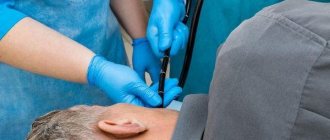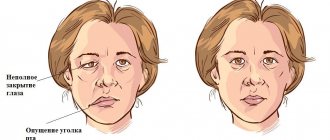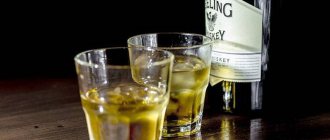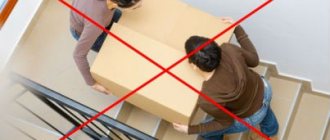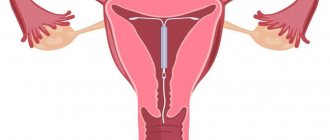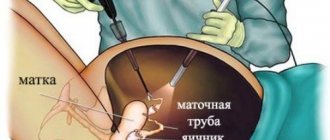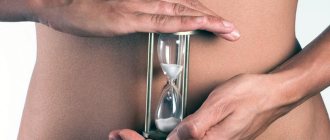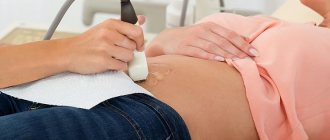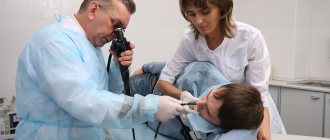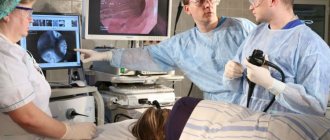Preparation period
The essence of FGDS is that a special tube with a small camera at the end is inserted through the mouth into the pharynx and further into the digestive tract, which allows you to display a picture on the display screen that characterizes the condition of the internal membranes of the organs. It is important that by the beginning of the study the stomach is completely empty and the food is completely digested. This allows you to increase the effectiveness of the method, obtain the most accurate results about the condition of the inner surface of the digestive tract and identify a hidden disease or clarify a previously assumed diagnosis. The last time you eat should be 10-12 hours before the start of the examination. If it is difficult for the patient to go without food for such a period of time, it is reduced to 8 hours.
The drinking regime also has its own restrictions, according to which the last drink is allowed a maximum of 2 hours before the specified time and in the amount of only one glass. It is allowed to drink warm boiled or mineral water without gases. Since most often the examination is carried out before lunch or in the morning, the optimal meal option would be: light dinner - good sleep - no breakfast.
How many hours before gastroscopy can you drink?
You should also not drink shortly before the procedure.
Knowing how much not to eat before FGDS, you need to clarify the rules of fluid consumption. You can drink 2-4 hours before the procedure. The stomach does not require much time to digest the liquid, and it is quickly eliminated. But if immediately before the procedure you want to take a sip of something refreshing, you need to abandon the idea.
If you need to take the medicine with water before the examination, you can take a few sips 20-30 minutes before the examination begins. If the drug is in tablets, it must be crushed before use.
What not to drink
For several days before gastroscopy, you should not drink alcoholic beverages, even low-alcohol ones.
A few hours before the procedure, it is better to drink only clean filtered water. If you buy a mineral one, choose one without gases. Avoid all other drinks, especially those containing flavors and dyes.
The total volume of liquid drunk before the examination is half a glass.
Restrictions
After setting the exact date for the endoscopic procedure, the patient is asked to adjust his diet. There is no special diet; it is rather recommended to limit the consumption of a number of foods that are poorly and difficult to digest, as well as changing the order of meals. Violation of this rule allows the doctor to cancel the prescribed procedure, since the following conditions may occur.
- The inserted endoscope often provokes a gag reflex, due to which food debris can enter the respiratory tract and worsen breathing, which will lead to unpredictable consequences.
- The presence of undigested food can distort the picture, which will affect the accuracy of the test results and the diagnosis will be incorrect.
Forbidden
4-5 days before the appointed date, the consumption of the following dishes and products is prohibited:
- fish, meat with high fat content;
- marinades, pickles;
- seeds, nuts, hazelnuts;
- the whole range of legumes;
- rye or coarse bread;
- pasta;
- sweets, baked goods;
- high fat milk;
- cream, sour cream;
- sausages, smoked meats;
- spices, herbs, seasonings;
- raw fruits and vegetables;
- sweet drinks (juices, fruit drinks, compotes) and carbonated drinks;
- coffee, strong tea;
- alcohol containing products.
Allowed
Experts advise including in your diet:
- low-fat fermented milk products;
- first courses with lean broth;
- boiled poultry, fish;
- butter, unleavened lightly salted cheeses;
- vegetables and fruits after heat treatment;
- pears, apples, banana, chopped or baked.
Nutritionists recommend drinking:
- compotes and decoctions based on fresh or dried fruits;
- weak strength tea;
- water without gases, preferably table mineral water;
- fruit drinks from berries, decoction of rose hips.
Prohibited Products
Carbonated drinks (including alcoholic drinks, kvass, lemonade and mineral water) from the diet that is recommended after FGDS It is also prohibited to drink strong tea or coffee as drinks, as they can stimulate the production of hydrochloric acid by the gastric mucosa.
Also, meat (chicken) broths can increase acidity, so they are also not included in the diet in the presence of hypersecretory conditions. Fatty meats (pork, duck, goose) have a similar effect. The diet also does not include soups with a large amount of spices, red borscht and okroshka.
Gels and suspensions will help cope with stomach pain. Which? This article will tell you about this.
Please note: Fresh baked goods negatively affect the digestive processes, as do pastry products. If a patient buys pies, then you need to pay attention to the nature of the filling.
With high acidity, fermented milk products (kefir, fermented baked milk) are not recommended. They can potentiate the effect of the aggression factor (hydrochloric acid) on the mucous membrane. Some types of hard cheese contain a large amount of spices and therefore should not be eaten.
If you look at vegetables, onions, radishes, rutabaga, cucumbers, spinach, and white cabbage are not included in the diet.
You should avoid eating peanuts, legumes, and nuts. All sour berries (blueberries, strawberries, lingonberries, gooseberries, currants) and citrus fruits are also undesirable.
Nutrition after the procedure
The responsibilities of the gastroenterologist performing fibrogastroduodenoscopy include not only performing the study, but also familiarizing potential patients with the rules of dietary nutrition after the end of the procedure, as well as explaining when they can eat after gastroscopy. In addition, the specialist is obliged to help lighten the diet and compose it by choosing light, gentle dishes.
Due to the irritation that occurs when the video probe passes through the digestive tract, gastroscopy is considered unpleasant and causes many people discomfort, burning, and, less often, nausea.
If FGDS was accompanied by the extraction of a sample of the affected tissue, then you can eat after a maximum of 4 hours. For an uncomplicated procedure – after 40-60 minutes.
Temporary dietary restrictions are associated with the use of an anesthetic - lidocaine, which is used to treat the pharyngeal mucosa. This is necessary to minimize the gag reflex and unpleasant conditions. It is recommended to start eating after the sensitivity of the tongue receptors has been restored.
First meal after the procedure
Immediately after FGDS of the stomach, you need to eat some light meals, abstaining from large meals and tonic drinks. Preference should be given to fermented milk products - kefir, yogurt, soft low-fat soups, porridges, vegetable purees. However, most people refuse to eat food immediately after gastroduodenoscopy. If no complications arise, then after FGS, doctors recommend adhering to the following diet plan:
- a small lunch including porridge or yogurt;
- a cup of tea, a glass of juice without sugar;
- in case of unpleasant sensations - only clean water.
It is undesirable to refrain from eating after FGDS, even if there are unpleasant sensations.
As soon as the nausea disappears, drink a cup of slightly sweetened tea and eat a small portion of cottage cheese. A long break in the functioning of the stomach can cause digestive disorders.
Food after gastroscopy
Strict restrictions are more relevant during the preparatory phase than for the post-diagnostic period. Of course, after FGDS there are certain features, but they relate more to the quality of the prepared dishes than to their prohibition. If no pathological changes have been identified, then the patient is allowed to return to the previous diet and eat as before, abstaining in the initial days from:
- hot drinks and dishes;
- fatty foods, smoked meats, pickled and salted vegetables, spicy spices.
In the case of diagnosing advanced diseases and any pathologies of the examined organs, the patient is instructed to switch to diet No. 1. It has its own characteristics and recommendations, which must be adhered to without fail.
- Eating should be divided into 5-6 meals.
- The amount of salt should be minimal or absent altogether.
- Dishes should be boiled, baked or steamed and eaten warm.
- The calorie content of the daily diet should not exceed 1500-2000 calories.
Resolution products
Since there are no special prohibitions on food, after FGDS you can return to your previous diet, including a wide variety of dishes. The list of permitted ones includes the following.
- Soups prepared with milk, vegetable broth or secondary broth from lean chicken.
- Bread made yesterday from first grade flour.
- Meat - lean beef, rabbit or poultry in the form of cutlets, meatballs, zrazy, cooked in a double boiler from lean beef, rabbit or turkey.
- Lean fish, baked or boiled. Steamed cutlets are allowed.
- Fresh whole milk or as a base for soup, as well as fermented milk products - kefir, yogurt, low-fat cottage cheese, sour cream.
- Cereals in the form of porridges, side dishes, additives to soups. Buckwheat and oatmeal are allowed. rice.
- Baked goods made from shortbread or savory dough - biscuits, cookies, pies with savory fillings.
- Vegetables - root vegetables, as well as boiled or steamed cauliflower, zucchini.
- Drinks – pure water without gases, juices, weak tea, weak cocoa, rosehip decoction.
- Butter only (in limited quantities) or vegetable oil.
Prohibited Products
Since the diet involves a number of restrictions and prohibitions, during the period of its adherence the patient is recommended to refrain from consuming:
- fried foods and fatty foods;
- pickles, marinades, smoked meats;
- strong meat, fish, chicken broths;
- mushrooms in any form;
- margarine and other cooking fats;
- cucumbers, cabbage, tomatoes;
- sour foods;
- cereals – barley, millet, pearl barley;
- baked goods from sweet dough;
- carbonated drinks, strong coffee.
Additional Tips
During the procedure, the digestive organs are exposed to mechanical stress from the endoscope tube. A foreign body, to some extent, disrupts the natural state of the gastrointestinal tract, therefore, after gastroscopy, it would be useful to maintain a dietary diet for 24–48 hours.
Typically, a gastroenterologist advises following the “table No. 1” diet. This is a gentle diet for people suffering from chronic gastrointestinal pathologies.
The basic principles of the diet are:
- Do not be greedy in food, that is, do not overeat.
- Do not consume food or liquid that is very hot. Do not burn the esophagus or stomach.
- Choose the right culinary method for processing food (cooking, steam mode, stewing). Fried foods should be excluded.
- Avoid hot spices, marinades and seasonings.
- Replace fatty meat with dietary chicken, turkey or lean beef;
- Avoid coffee, baked goods and soda.
- Give preference to stewed vegetables, cereals, pasta.
- Do not flavor food with mayonnaise-based sauces, ketchups, mustard, etc.
Based on the results of FGDS, the doctor will diagnose the disease, prescribe the necessary medications, and help adjust the diet. If the examination does not reveal any serious pathologies, you can return to your normal diet. The transition should not take place in a forced mode. Solid and heavy foods are introduced gradually to avoid indigestion and dyspepsia (difficult and painful digestion).
If, while following all the nutritional rules, the patient experiences pain in the gastrointestinal tract, irregular bowel movements, or diarrhea for more than three days, the doctor should be notified. The procedure may have had some complications.
In the article we tell you how many hours before FGDS you can’t eat, and how long after the procedure you can. You will learn what foods and drinks doctors do not recommend consuming before and after gastroscopy.
Features of table No. 1
The diet prescribed for pathologies of the gastrointestinal tract has its own characteristics, which the patient must be aware of.
- The duration of the restricted diet is determined by the doctor, and as a rule, it is 2 weeks. The exception is cases when a biopsy sample was taken. In this situation, you must follow the diet for a month.
- To avoid irritation of the gastric and duodenal mucosa, you should eat small portions.
- During this period you should eat in small portions, increasing the number of meals to 5-6 times a day. The last time you should eat is 3 hours before bedtime.
- Temperature requirements must be observed: avoid eating hot and cold foods. Food should be moderately warm.
- For complete absorption of food, it is necessary to comply with the drinking regime. The daily volume of liquid should not be less than 1.5 liters of water.
When switching to a normal diet after FGDS, doctors recommend introducing certain foods gradually. A large load on the gastrointestinal tract can trigger new digestive problems and cause more serious complications.
Is it possible to drink alcohol before donating blood for sugar?
- Is it possible to drink alcohol before donating blood for sugar?
- How to do bad tests
- How to drink glucose
The key method in diagnosing carbohydrate metabolism disorders is a blood sugar test. According to indications, this study is carried out on an empty stomach or 2 hours after a meal. The norm is considered to be fasting blood sugar in the range of 3.3-5.5 mmol/l. To avoid mistakes when taking blood, you need to properly prepare. An important point is to avoid alcoholic beverages on the day of the study and the day before.
Why does alcohol reduce the accuracy of blood sugar tests?
Under the influence of alcohol, the blood sugar level changes, which sharply reduces the likelihood of a correct diagnosis based on the examination results. In addition, alcoholic beverages reduce the accuracy of the study due to the effect on medical equipment and reagents. Alcohol metabolism products enter into chemical reactions with laboratory substances, which makes accurate determination of blood sugar impossible. Diagnostic systems based on enzymatic techniques are considered the most accurate. The error can be quite significant.
